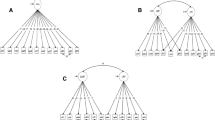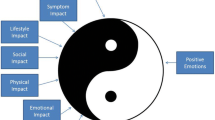Abstract
Background
Hemophilia experts have recommended that screening tools should be introduced into clinical practice to assess patients’ needs and perceptions.
Purpose
The present work aims to describe the development of a brief instrument for the assessment of subjective well-being of men with hemophilia within an international study involving participants from 10 countries.
Methods
Several steps were implemented toward achieving this objective: (1) literature review; (2) semistructured interviews in different Ibero-American countries; (3) exploratory qualitative content analysis of the interviews; (4) definition of the construct being evaluated; (5) generation of preliminary items; (6) interjudgment ratings of the items, by both patients and experts, to assess comprehension and review items; and (7) psychometric testing of an international sample of 342 patients with hemophilia.
Results
Exploratory qualitative study allowed the development of an initial pool of items which adress salient life domains related to well-being. Interjudment ratings led to improvents in the wording and comprehensibilty of the preliminary pool of questions. Psychometric testing allowed items to be reviewed according to empirical criteria. The assessment of the underlying structure of the questionnaire by exploratory factor analysis (generalized least squares) showed a unidimensional model explaining 59.7 % of variance. Adequate internal consistency (0.91) and test–retest reliability (0.82) were observed for the instrument. Associations with other outcome measures and clinical indicators also provided a range of evidence for the instrument’s validity.
Conclusions
This study presents a new disease-specific tool which is able to assess subjective well-being in hemophilia patients.The instrument is available in Spanish, Portuguese (Brazilian), and English language versions for use in future research.
Similar content being viewed by others
References
World Federation of Hemophilia. Guidelines for the management of hemophilia. Quebec: WFH; 2005.
Dolan G. The challenge of an ageing haemophilic population. Haemophilia. 2010;16:11–6.
Salek SZ, Benson GM, Elezovic I, Krenn V, Ljung RC, Morfini M, et al. The need for speed in the management of haemophilia patients with inhibitors. Haemophilia. 2011;17:95–102. doi:10.1111/j.1365-2516.2010.02265x.
Remor E. Quality of life in hemophilia. In: Rodríguez-Merchán EC, Valentino LA, editors. Current and future issues in hemophilia care. Oxford: Wiley-Blackwell; 2011. p. 49–54. doi:10.1002/9781119979401.ch11.
Arranz P, Remor E, Quintana M, Villar A, Díaz JL, Moreno M, et al. Development of a new disease-specific quality-of-life questionnaire to adults living with haemophilia. Haemophilia. 2004;10:376–82.
Triemstra AH, Van der Ploeg HM, Smit C, Briët E, Adèr HJ, Rosendaal FR. Well-being of haemophilia patients: a model for direct and indirect effects of medical parameters on the physical and psychosocial functioning. Soc Sci Med. 1998;47:581–93.
Remor E. Development of a disease-specific measure to the assessment of quality of life in adult patients living with hemophilia in Latin America: the HemoLatin-QoL. Interam J Psychol. 2005;39:211–20.
Remor, E. Predictors of treatment difficulties and satisfaction with haemophilia therapy in adult patients. Haemophilia. 2011;17. doi:10.1111/j.1365-2516.2011.02578.x.
Sirgy MJ. The psychology of quality of life. Dordrecht: Kluwer Academic; 2002.
Bullinger M. Quality of life—definition, conceptualization and implications—a methodologist’s view. Theor Surg. 1991;6:143–9.
Eignor DR. Standards for the development and use of tests: the standards for educational and psychological testing. Eur J Psychol Assess. 2011;17(3):157–63.
Revicki DA, Gnanasakthy A, Weinfurt K. Documenting the rationale and psychometric characteristics of patient-reported outcomes for labeling and promotional claims: the PRO evidence dossier. Qual Life Res. 2007;16(4):717–23.
Anatchkova MD, Bjorner JB. Health and role functioning: the use of focus groups in the development of an item bank. Qual Life Res. 2010;19:111–23.
Nunnally JC, Bernstein IH. Psychometric theory. 3rd ed. New York: McGraw-Hill; 1994.
The EuroQol Group. EuroQol—a new facility for the measurement of health-related quality of life. The EuroQol Group. Health Policy. 1990;16(3):199–208.
Ware JE, Kosinski M, Bjorner JB, Turner-Bowker DM, Gandek B, Maruish ME. User’s manual for the SF-36v2 Health Survey. 2nd ed. Lincoln: QualityMetric Incorporated; 2007.
Corbin JM, Strauss AC. Basics of qualitative research: techniques and procedures for developing grounded theory. 3rd ed. London: Sage; 2008.
Lord FM, Novick MR. Statistical theories of mental tests scores. Reading: Addison-Wesley; 1968.
Anastasi A, Urbina S. Psychological testing. Englewood Cliffs: Prentice Hall; 1997.
Spaan M. Test and item specifications development. Lang Assess Q. 2006;3(1):71–9.
Costello AB, Osborne JW. Best practices in exploratory factor analysis: four recommendations for getting the most from your analysis. Pract Assess Res Eval. 2005;10(7):173–8. http://pareonline.net/pdf/v10n7.pdf. Accessed 1 Sept 2011.
Brow TA. Confirmatory factor analysis for applied research. New York: Guilford; 2006.
Acknowledgments
The author wishes to thank the experts, health professionals, and voluntary patients from the Ibero-American countries who took part in the study and carried out data collection as part of this work. The present study was partially supported by grants to the author from “Centro de Estudios para América Latina (UAM),” reference PD 02-541A-Q-640 (during the period 2002–2004), and “Consejería de Educación, Comunidad de Madrid/UAM,” reference CCG08-UAM/HUM-4462 (during the period 2009–2010).
Conflict of Interest
The author has no interests that might be perceived as posing a conflict or bias.
Author information
Authors and Affiliations
Corresponding author
Appendix: Hemophilia Well-being Index (HWBI)
Appendix: Hemophilia Well-being Index (HWBI)
Researchers interested in the HWBI and scoring instructions should contact the author for proper authorization before its use.
English version
During the last month, to what extent have the following areas of your life been negatively affected by hemophilia?
1. Family
2. Health/well-being
3. Work or school
4. Friends and relationships
5. Love life and partnership
6. Economic status
7. Leisure time
8. Social activities
Response format: 4 = Strongly affected, 3 = Quite affected, 2 = Somewhat affected, 1 = A little affected, 0 = Not affected
International Spanish version
Durante el último mes ¿hasta qué punto las siguientes áreas de tu vida han sido afectadas negativamente por la hemofilia?
1. Familia
2. Bienestar/Salud
3. Trabajo o Escuela
4. Amigos y Relaciones afectivas
5. Vida sentimental y Relación de Pareja
6. Situación económica
7. Actividades recreativas u ocio
8. Actividad social
Formato de respuesta: 4 = Muy afectada, 3 = Bastante afectada, 2 = Algo afectada, 1 = Poco afectada, 0 = Ninguna afectación
Brazilian Portuguese version
Durante o ultimo mês, em que medida as seguintes áreas de sua vida foram afetadas negativamente pela hemofilia?
1. Família
2. Bem-estar/Saúde
3. Trabalho ou Escola
4. Amigos e Relações afetivas
5. Vida sentimental e Relação de casal
6. Situação econômica
7. Atividades recreativas ou lazer
8. Atividade social
Formato de resposta: 4 = Muito afetada, 3 = Bastante afetada, 2 = Algo afetada, 1 = Pouco afetada, 0 = Nenhuma afetação
Rights and permissions
About this article
Cite this article
Remor, E. Development and Psychometric Testing of the Hemophilia Well-being Index. Int.J. Behav. Med. 20, 609–617 (2013). https://doi.org/10.1007/s12529-012-9261-2
Published:
Issue Date:
DOI: https://doi.org/10.1007/s12529-012-9261-2




